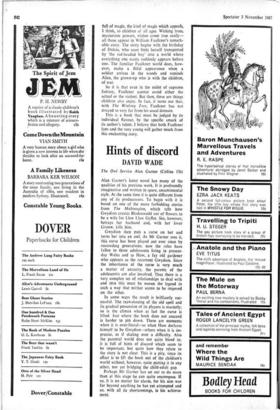The Wi.shing Tree William Faulkner
Full of magic
ELIZABETH JENNINGS
illus-
trated by Don Bolognese (Chatto and Vs'indus 18s) William Faulkner seems the most unlikely person to have written a children's book. He is, after all, the maker of very adult epics— nothing for the young there, it would seem. Yet, he did leave a story for children and it has a very curious and interesting history. This story first appeared as a small volume typed and bound by its author and dated February 1927. However, an earlier draft, of which there are several copies, still exists. Thst, perhaps, is all we really need to know about the birth of this undoubted 'find.
All of the American South moves through this ingenious tale; yet, like all fairy-tales (and it is that above all else), The Wishing Tree is
full of magic, the kind of magic which appeals, I think, to children of all ages. Wishing trees, mysterious powers, wishes come true easily— all these appear in William Faulkner's remark- able story. The story begins with the birthday of Dulcie, who soon finds herself transported by 'the red-headed boy' into a world where everything one wants suddenly appears before one. The familiar Faulkner world does, how- ever, make a fitful appearance when a soldier arrives in the woods and reminds Alice, the grown-up who is with the children, of war.
So it is that even in the midst of supreme fantasy, Faulkner cannot avoid either the actual or the violent. But then, these are things children also enjoy. In fact, it turns out that, with The Wishing Tree, Faulkner has not strayed so very far from his usual domain.
This is a book that must be judged by its individual flavour, by the specific smack of its author's talent. I believe that both Faulkner fans and the very young will gather much from this enchanting story.











































 Previous page
Previous page